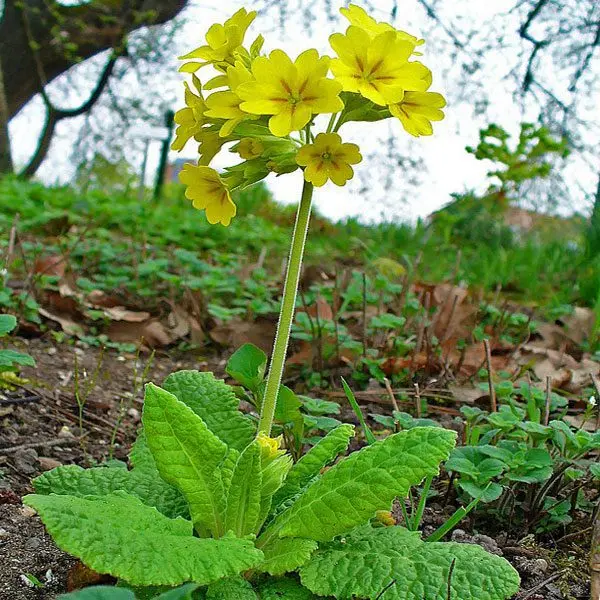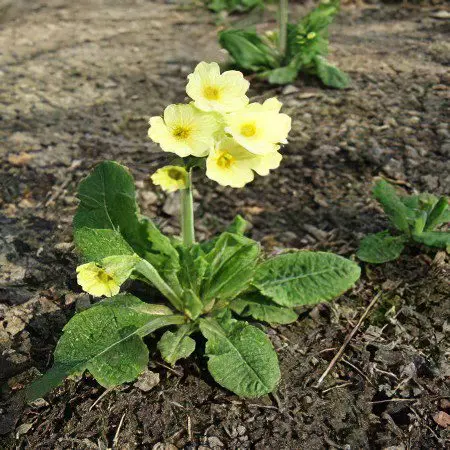Contents
Botanical characteristics of spring primrose
Primrose – This is a beautiful perennial plant from the popular primrose family. The plant has a short oblique rhizome. The leaves of this grass are represented by wrinkled oblong plates 15 cm long with a crenate edge. Flowering stems vary from 10 to 25 cm, at the ends of them are umbellate inflorescences. The calyx of the spring primrose consists of 5 green sepals, which are fused together.

Pollination of this plant is carried out by insects by a cross method. The fruit in the form of an ovoid box pleases with a large number of small seeds. The presented grass blooms in May. The fruits ripen in June, after which seeding occurs. Spring primrose is widespread mainly in Europe and in the western regions of Russia. It is found on the edges and clearings, in clearings and clearings, among various shrubs and in numerous light forests, as well as in steppes and large forest ravines. In some places, this plant is able to form fairly dense clusters.
Useful properties of primrose
Such a medicinal plant is also decorative and food. The leaves and young flower-bearing arrows contain substantial reserves of ascorbic acid, up to 5,9%. – that is, only 1,5 grams of a leaf of this plant will satisfy the daily need for vitamin C [1].
The leaves are used as a tea for beriberi, and the powder of the leaves is also added to the first courses. Rhizome with roots contains up to 10% triterpene saponins. It is used as a decoction as an expectorant. Flowers are used in the form of decoctions and infusions for migraines, neuralgia, colds, gout and rheumatism, insomnia, cough.
Alcoholic tincture of flowers is used as a sedative for insomnia and overexcitation. An infusion of leaves is used for gout, kidney and bladder diseases. A decoction and tincture of the root are prescribed as an emollient and expectorant for coughs, as a diuretic. Outwardly, a decoction is used for rinsing with inflammation of the throat, larynx and bronchitis.
The use of primrose
Unique infusions of such herbs are recommended to be taken orally to enhance the secretion of bronchial glands, since primrose is rich in vitamin A. To prepare a great decoction, you need to chop the leaves in the amount of 1 teaspoon and pour them with a glass of boiling water. After half an hour of infusion, you can take half a glass of funds in the morning and evening.
To get rid of bronchitis or bronchial asthma, you should prepare such an infusion: 10 grams of primrose leaves are poured into 200 ml of hot water. Then the mixture must be heated in a water bath for 15 minutes and left for forty minutes to cool, after which it is recommended to strain the composition well and take 1 tablespoon 4 times a day. In addition, the rhizomes of this plant are often used as a diuretic and expectorant.
Primrose syrup
Spring primrose syrup has a brownish tint and a specific smell. It is used in complex therapy as an excellent expectorant during inflammatory diseases such as tracheitis and bronchitis. It is also indispensable for acute respiratory infections with a dry unpleasant cough.
Primrose oil
Incredibly useful primrose oil becomes such thanks to gamma-linoleic acid. It is known that it is rich in special fats that contribute to excellent well-being and good health. Primrose oil has a great effect on the cardiovascular system of the human body, normalizes the optimal level of hormones, strengthens the immune system, and also improves the condition of the joints. It is recommended to take this wonderful oil 2 times a day – before breakfast and preferably before lunch. The standard dose is 2 grams per day.
Primrose syrup “Herbion”
The popular primrose syrup “Gerbion” is a unique preparation of plant origin. It is a powerful expectorant and anti-inflammatory agent, and also has an antimicrobial effect and reduces the viscosity of sputum. As a rule, “Gerbion” is indicated as an additional tool in complex therapy in the treatment of tracheitis and bronchitis. Side effects from taking in rare cases are allergic reactions, sometimes nausea and vomiting, and diarrhea is almost never observed.
Scarlet primrose
Scarlet primrose is a special species from the primrose family. This plant blooms unusually beautifully with scarlet small inflorescences. Such an annual grass has wavy leaves with hairs, which are presented in the form of a basal rosette. Scarlet primrose blooms in early spring.
Primrose large-cup

Primrose large-cupped is an annual plant, which is distinguished by short-pubescent leaves and fragrant pale yellow flowers. Flowering of this herb occurs at the end of May. This species grows in forest meadows and between shrubs, choosing mixed forests. Large cup primrose contains essential oil, saponins, glycosides, flavonoids, primalaverin, primzerin, manganese, which is indispensable for the human body, as well as the unique element carotene and important ascorbic acid.
In folk medicine, this herb is in particular demand because it has an expectorant effect. Moreover, it will help to quickly cope with chronic constipation and overwork.
primrose leaves
The infusion of the leaves of this wonderful plant is not in vain associated with an effective tonic and tonic. It is useful in spring beriberi, while eliminating overwork. At home, you can easily prepare such a decoction. We take 15 grams of crushed primrose leaves and combine them with a glass of fairly warm water. After 2 hours, it is recommended to take this delicious infusion 4 times a day, 1 tablespoon. In addition, this decoction is effective for sore throats, flu and other colds.
bulbous primroses
Bulbous primroses are early spring plants with blue flowers and pale green pointed leaves. Such grass appears immediately after the snow melts. This graceful unpretentious plant can reach a height of 30 cm. The racemose inflorescences of flowers boast a special blue stripe in the middle of the perianth lobe. This small-bulbous plant propagates by vegetative-daughter bulbs. Such grass prefers semi-shady places with good loose soil.
Primrose honey
The nectary of the primrose is located at the very base of the column. Such a wonderful plant blooms for about three weeks – in early spring, and sometimes in early summer. Pollen has a pleasant yellow hue. Bees love to visit the primrose to collect nectar and pollen.
Primrose during pregnancy
Future mothers are not recommended to take primrose, as it can cause uterine contractions.
Contraindications to the use of primrose
If you strictly observe the dosage, then side effects can be avoided. But it is worth noting that it is not recommended for allergy sufferers to use such a plant. In addition, it is not necessary to use primrose with its individual intolerance, as well as with peptic ulcers.









